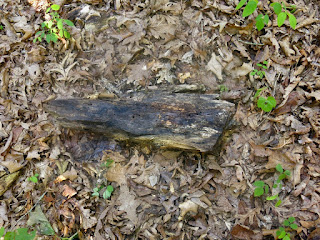Mark Bower sent me these pictures in an email. "I turned over this piece of wood, looking for slime molds. Instead, there was this slimy salamander. On the under-surface of the wood were these white things, which I assume are salamander eggs?"
 |
| Home of a slimy |
Now it is perfectly normal for a naturalist to roll over logs looking
for salamanders but what kind of man would be looking for a slime
mold? My mother in the 1950s used to say, "There is no
accounting for taste, said the woman as she kissed her cow."
Slimy salamanders (Plethodon albagula) breed annually, depositing about 6-36 eggs under logs or soil in the summer or early fall so it is possible that these are its eggs. They get their name from.....you guessed it, slime. I can attest to the following statement from the MDC Field Guide. "This species secretes a thick, very sticky substance that adheres to
skin like glue. It causes dust, dirt or bits of dead leaves to stick to
one’s hands and is difficult to remove."
I once asked Chris Barnhart this same question about removing tenacious slug slime and he said, "I usually just turn to a colleague and rub his shoulders while giving him a pat on the back." It has worked for me when out hiking with Mark.
Back to slime molds, why would Mark look for them? The answer... why go to an art museum? Look at Mark's gallery of slime molds and decide for yourself.
Ruth Grant sent this fascinating article on Slime Molds Remember — but Do They Learn?
Ruth Grant sent this fascinating article on Slime Molds Remember — but Do They Learn?


















































